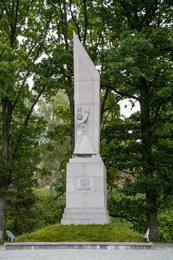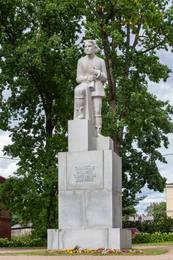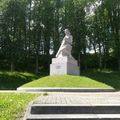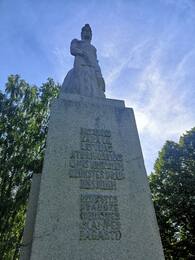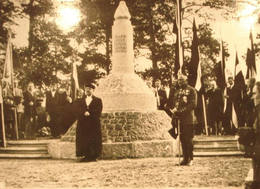Skulptorius Kārlis Zemdega (1894-1963)
II Antrasis pasaulinis karas, IV Sovietų okupacija
Kārlis Zemdega (iki 1935 m. – Kārlis Baumanis) gimė 1894 m. balandžio 7 d. Cīravos valsčiuje.
Mokėsi Cīravos parapinėje mokykloje ir Dunalkos pradžios mokykloje. Baigė Aizputės miesto mokyklą. Mokymąsi tęsė Rygoje Blumo piešimo mokykloje ir Dailės akademijoje, kur studijavo ir skulptūrą, ir piešimą.
1927 metais baigė Konstantino Rončevskio vadovaujamas Skulptūros dirbtuves darbu „Jokūbo kova su angelu“. Tada toliau dirbo Taikomosios skulptūros dirbtuvėse, kur mokėsi akmens apdirbimo techninių technikų. Kadangi turėjo finansinių sunkumų, studijoms turėjo užsidirbti dirbdamas valstybės tarnautoju ir piešimo mokytoju. Dailės akademijoje dirbo dėstytoju - Skulptūros cecho vedėju (1940 - 1941), profesoriumi (1947 - 1962), kartu dirbo užsakymuose.
Kārlis Zemdega sukūrė Rainio antkapinį paminklą Rainio kapinėse, Rygoje (1935 m.), yra Rainio paminklo Rygoje, Esplanadoje, projekto autorius (1965 m. materialiai įgyvendino skulptoriai Laimonis Blumbergs ir Aivars Gulbis). Jis yra kelių memorialinių paminklų, skirtų I pasauliniame kare ir Nepriklausomybės kovų aukoms atminti – „Koklētāja“ Raunoje (1933), Viļaka (1935), žuvusiems Džūkstėje (1935), „Tālavas tauretāja“ (1937 m.), „Doļēdėja.937“ Rūjienoje redagavo Kārlis Zemdega ir pastatė Vilnis Titāns 1996 m.). Paminklas „Sėjėjas“ Rūjienoje skirtas buvusiam Latvijos ministrui pirmininkui Artūrui Alberingui (1876—1934). Zemdega daugiausia kūrė monumentalius kūrinius, tačiau jo kūryboje yra ir keletas reikšmingų portretų bei figūrinių kūrinių.
Kārlis Zemdega mirė 1963 metų lapkričio 9 dieną Rygoje ir buvo palaidotas Rainio kapinėse.
1975 m. Ciravos valsčiuje buvusioje „Gailių“ rezidencijoje, kur gimė skulptorius, pastatytas paminklinis akmuo.
Daugiau informacijos šaltinių
Susijęs su Aizpute ir apylinke. Biografinis žodynas: http://vardnica.aizpute.lv/33-personas-z/670-zemdega-karlis
Vija Gunė. Noriu didelių šviesiai mėlynų sparnų: versija apie Kārlį Zemdegą. Ryga: Žvaigzne ABC, 1995 m.
Karlis Zemdega. „Ir aš pakilsiu stiprus...“ Koncepcija ir aranžuotė – Ingrīda Burāne. Ryga: Mokslas, 2019 m.
Susijusios vietos
Laisvės paminklas Raunoje
Skulptoriaus Kārlio Zemdegso sukurtas paminklas skirtas Raunos parapijos narių, žuvusių Pirmajame pasauliniame kare ir Nepriklausomybės kovose, atminimui.
Kaip vienas iš neįgyvendintų Rygos Laisvės paminklo projekto variantų, jis buvo atidengtas 1933 m. rugpjūčio 20 d. Atidarymo renginyje dalyvavo trečiasis Latvijos Respublikos prezidentas Albertas Kviesis.
Originalus paminklo pavadinimas buvo „ES DŪR“ – šūkis – ietis virsta kokle, o žmones išgelbėja dainos dvasia. Paminklo pagrindą puošia Baumanių Kārlio sukurtos giesmės „Dieve, laimink Latviją“ žodžiai.
Prieš paminklo atidengimą 1933 m., Raunės gyventojai, tvarkydami paminklą, pasodino ąžuolų alėją ir po kiekvienu ąžuolu pastatė kapsulę su žuvusio kario vardu. Vėliau, 1937 m., kovotojų vardai buvo išgraviruoti ant baltos marmurinės plokštės, kuri yra bažnyčioje.
Komunistinės okupacijos metu užrašas „Dieve, laimink Latviją“ buvo nuimtas nuo postamento. Jis buvo atstatytas 1989 m. birželį, prasidėjus Atgimimui.
Paminklas „Talavos trimitininkas“
Įsikūręs Rūjienos centro aikštėje.
Trijų metrų aukščio senovės Latvijos gvardijos kareivio atvaizdas, išdrožtas iš pilko suomiško granito, vadinamas „Tālavo trimitininku“, pastatytas ant trijų metrų aukščio granito pjedestalo, tačiau bendras paminklo aukštis siekia 7,5 metro. Pradiniuose eskizuose ir modeliuose K. Zemdega į kario rankas įdėjo kardą, kuris vėliau buvo pakeistas trimitu. Paminklas buvo atidengtas 1937 m. rugpjūčio 15 d.
Šis paminklas atspindi sunkią mūsų valstybės ir kariuomenės kūrimosi situaciją, taip pat šių įvykių vertinimą. Iškart po Latvijos valstybės paskelbimo prasidėjo Raudonosios armijos puolimas, o laikinoji Karlo Ulmanio vyriausybė rado prieglobstį Liepojoje. 1919 m. vasarį, padedant Estijos armijai, prasidėjo Latvijos išlaisvinimas iš šiaurės, o Rūjienos apylinkėse įvyko pirmosios Tērbate besiformuojančių Latvijos kariuomenės mobilizacijos, kurios, vadovaujamos pulkininko Jorgio Zemitano, tapo Šiaurės Latvijos brigada. Šiaurės Latvijos brigada kovojo ne tik su bolševikais, bet ir su landesveru bei Geležine divizija Cėsių mūšiuose. Rūjienos apylinkėse mobilizuoti Šiaurės Latvijos kariai kovojo ir vėlesniuose Nepriklausomybės karo mūšiuose. Po karo pagrindiniai pergalės laurai atiteko generolui Jāniui Balodžiui ir jo vadovaujamai Pietų Latvijos brigadai, tačiau Šiaurės Latvijos brigada dažnai buvo pamirštama. Rūjienoje planuojamas Šiaurės Latvijos brigados paminklas taip pat užtruko ilgai, o 1937 m. atidengtas paminklas oficialiai buvo reklamuojamas kaip Rūjienos krašto išlaisvinimo ir žuvusių karių atminimo paminklas, nepaminint, kad visi Šiaurės Latvijos brigados pulkai savo ištakas turėjo Rūjienoje.
Paminklas yra ne tik populiari turistų lankoma vieta Latvijos ir Estijos turistams, tam tikru mastu tapusi atspirties tašku norint aplankyti keletą kitų Nepriklausomybės karo memorialinių vietų Rūjienoje, bet „Tālavas tauretājs“ yra ir sustojimo vieta įvairaus lygio Estijos ir Latvijos valstybės bei vietos valdžios pareigūnams.
Rūjienos išlaisvinimo ir žuvusių karių paminklas, geriau žinomas kaip „Tolamas tauretājs“ (Tolimas ragas), 1998 m. spalio 29 d. buvo įtrauktas į valstybės saugomų kultūros paminklų sąrašą kaip nacionalinės svarbos meno paminklas (paminklo apsaugos registracijos numeris 4522).
Paminklas „Smuikininkas“
Paminklas „Koklētājs“ Talsuose, Ķēniņkalnyje, skirtas Laisvės kovotojų atminimui (autoriai K. Zemdega, skulptorius V. Titans). Ketvirtojo dešimtmečio pabaigoje Talsų miesto taryba pavedė skulptoriui K. Zemdegai (1894–1963) sukurti paminklą. 1938 m. skulptorius pagamino gipsinį skulptūros modelį, o kapsulė su žinute ateities kartoms apie paminklo sukūrimo istoriją buvo palaidota Leči kalne. Antrasis pasaulinis karas šią idėją sustabdė, tačiau atlieja buvo paslėpta ir išsaugota. Atkūrus nepriklausomybę, paminklo užbaigimo idėja atgijo. V. Titans pradeda drožti „Koklētājs“ akmenyje Žemės ūkio technikos muziejuje „Kalėjai“. Paminklas buvo atidengtas 1996 m. lapkričio 16 d., ceremonijoje dalyvavo ir tuometinis Latvijos prezidentas G. Ulmanis.
K. Zemdegos paminklas Pirmojo pasaulinio karo aukoms Tukume
Įsikūręs Tukume, Saulės kalno papėdėje.
Karlo Zemdegos suprojektuotas paminklas „Šaulys“ yra vienas iš paskutiniųjų paminklų, atidengtų 1940 m., prieš Latvijai prarandant nepriklausomybę. Jame pavaizduotas jaunas kareivis, klūpantis ir prisiekiantis ištikimybę Tėvynei. Paminklo papėdėje yra Brolių kapinės, kuriose palaidota daugiau nei 40 žmonių.
Pirmojo pasaulinio karo metu, kai Kuržemė buvo okupuota vokiečių, Pavārkalno šlaite buvo įkurtos kapinės. Jose buvo laidojami žmonės, kuriuos vokiečių karo teismas sušaudė ir nuteisė mirties bausme. Iš pradžių kapai buvo numeruojami ir tik 1925 m. pavyko išsiaiškinti visų nuteistųjų tapatybes. Tai daugiausia buvo sugauti Latvijos šauliai. Tarp jų buvo ir civilių. Vėliau žmonių palaikai buvo perlaidoti kartu su žuvusiais Latvijos armijos kariais toje vietoje, kur K. Zemdegos paminklo papėdėje buvo sukurti Brolių kapai.
Šiandien galite aplankyti memorialinę vietą. K. Zemdega sukūrė keletą puikių paminklų, įskaitant ir Tukume esantį.
Paminklas Dzūkų ir Slampės parapijų vaikams, žuvusiems Pirmajame pasauliniame kare ir Latvijos išsivadavimo mūšyje
Paminklas Dzūkų ir Slampės parapijų sūnums, žuvusiems Pirmajame pasauliniame kare ir Latvijos išsivadavimo kovose, buvo atidengtas 1935 m. lapkričio 17 d. Autorius yra vienas geriausių Latvijos skulptorių – Karlas Zemdega.
Paminklas Jaškove Latvijos išsivadavimo kovoje žuvusiems kariams
Įsikūręs kairėje Viliakos–Vientulio kelio atkarpos (P35) pusėje, šalia Jaškovos kapinių koplyčios.
Paminklas Latvijos ir Estijos kariams, žuvusiems Nepriklausomybės kare.
Skulptoriaus Kārlio Zemdegos sukurtas paminklas 1920 m. Jaškove žuvusiems Išvadavimo kare kariams atminti pirmą kartą buvo atidengtas 1935 m. rugsėjo 22 d. Viliakos brolių kapinėse, įkurtose 1929 m.
Laisvės kova prieš Raudonąją armiją Viliakos krašte prasidėjo 1920 m. sausio 9 d., kai Latvijos armija ir Latgalos partizanų pulkas užpuolė miestą. Jose dalyvavo ir Estijos kareiviai. Viliaka buvo išlaisvinta sausio 9 d., tačiau kovos į rytus nuo jos tęsėsi dar kelias dienas. Tiek prieš, tiek po Viliakos išlaisvinimo žuvę kareiviai buvo laidojami įvairiose vietos gyventojams žinomose vietose. Latvijos valstybei stabilizuojantis, pradėta galvoti apie bendrų brolių kapinių įrengimą Viliakoje. Jau 1923 m. lapkričio 18 d., po iškilmingų pamaldų katalikų bažnyčioje, kurias vedė dekanas P. Apšinīkas, didelė procesija patraukė į naujai įkurtas brolių kapines ant kalvos, vadinamuosiuose Jaškove – visai netoli Viliakos. Netrukus buvo padėti paminklo pamatai ir pradėtos rinkti aukos paminklui. Žuvusių kareivių kapų identifikavimas užtruko, ir tik 1929 m. lapkričio 3 d. įvyko perlaidojimas būsimose brolijos kapinėse. Jose buvo palaidoti 31 Latvijos ir 14 Estijos kareivių, žuvusių Viliakos apylinkėse. 1935 m. paminklas buvo paruoštas ir iškilmingai pašventintas rugsėjo 22 d.
Iki karo Latvijos nepriklausomybės metais visi svarbūs nacionaliniai įvykiai Viljakos parapijoje buvo susiję su brolių kapais ir šiuo paminklu.
Paminklas buvo sunaikintas pokario sovietmečio metais, tačiau jo granito dalys, nors ir pažeistos, buvo išsaugotos. Paminklas buvo restauruotas 1990 m. lapkričio 11 d. – Lačplėsio dieną.
Susijusi istorija
Raunos laisvės paminklas arba paminklas Pirmajame pasauliniame kare ir Laisvės kovose žuvusiems Raunos parapijos nariams atminti
Raunos Laisvės paminklo idėjos ištakos siekia 1929 metų rugpjūčio 21 dieną, kai Cėsių meras ir Cėsių rajono vadovas į susitikimą pakvietė iškiliausius Raunos parapijos visuomenės veikėjus, pakvietę pagerbti laisvės pasiekimą ir pastatyti paminklą Raunoje.







